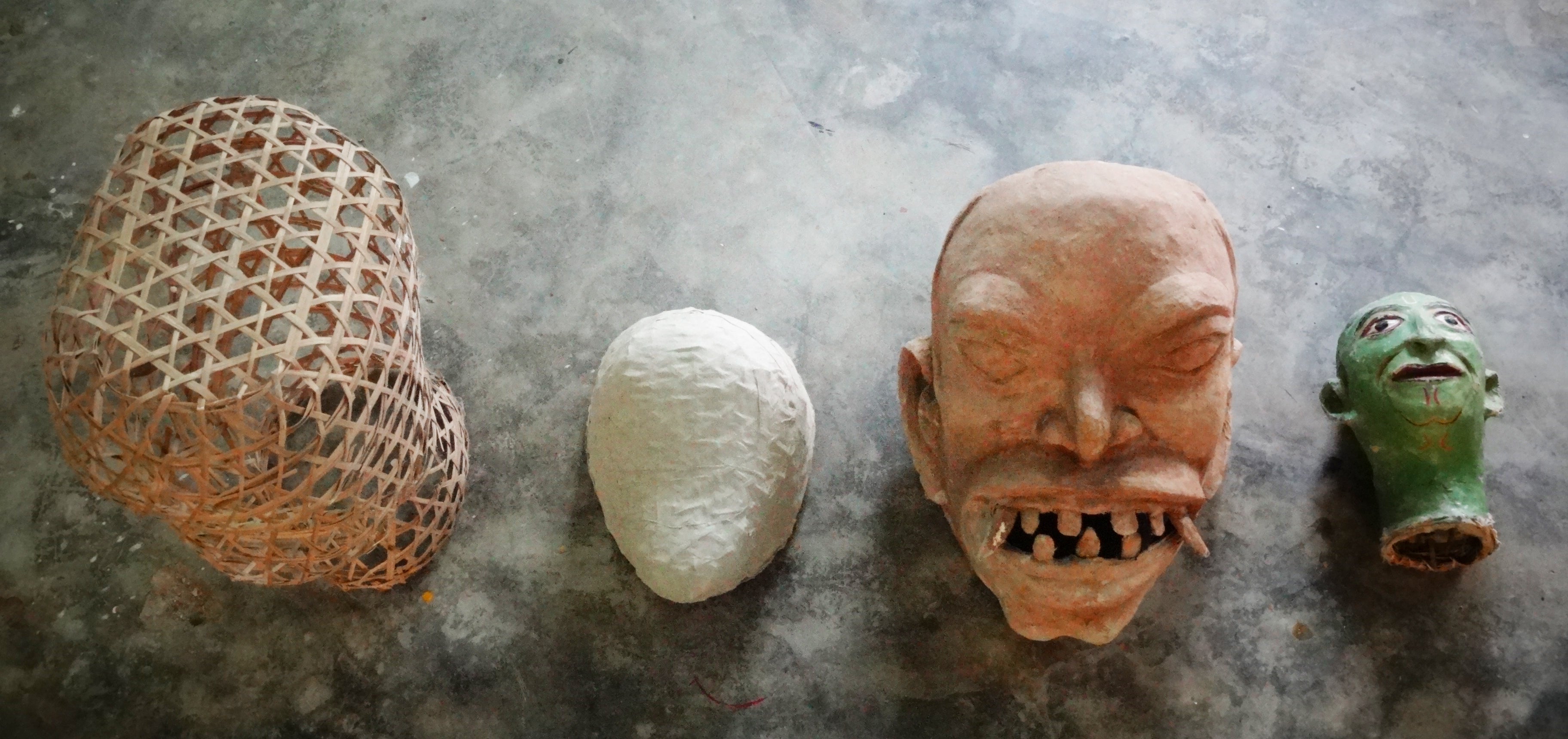When we think of Assamese mask-making, Majuli instantly comes to mind. This river island is famous for its intricate bamboo masks, an art passed down through generations. However, hidden in the historic town of Sivasagar, two lesser-known satras (monasteries)—Khatpar Satra and Katonipar Satra— have been quietly preserving this craft for centuries.
In the interiors of the historic town of Sivasagar, Assam, skilled artisans continue the ancient tradition of crafting handmade bamboo masks, though their work remains largely unrecognized. Khatpar Satra is known for its bamboo masks, while Katonipar Satra goes beyond masks, producing religious artifacts and utility items such as Xingakhon (traditional wooden deity thrones), thoga (religious book stands), Gosa (lamp stands), doba & khul (traditional drums), welcome gates for satras, wooden and cement sculptures.
 Some of the products made by the artisans
Some of the products made by the artisans
Despite this rich artistic heritage, only two families in these satras continue mask-making today—and not as a full-time profession. Economic challenges and alternative careers have led younger generations away from this craft.
The mask-making tradition of Khatpar Satra spans four generations. Shri Gopikanth Mahanta is credited with laying its foundation, while Shri Rebakanta Mahanta elevated Assamese mask-making to the global stage. His exceptional contribution was recently recognized with the Padma Shri, one of India's highest civilian honours.
 Padma Shri Rebekanta Mahanta
Padma Shri Rebekanta Mahanta
Locally known as Mukhas, these masks play a crucial role in Bhaona, a traditional Assamese theatrical performance depicting stories from the Ramayana and Mahabharata. Used to portray gods, demons, and mythological characters, these handcrafted bamboo masks bring folklore to life, making them an essential part of storytelling.
One of the most fascinating aspects of this craft is its use of natural and eco-friendly materials. The primary ingredients include bamboo, cane, potter’s clay (sticky soil), wood, cotton cloth, natural dyes, and adhesive. The process demands exceptional skill, with years of practice required to master the art.
The making of a mask involves several meticulous steps. First, artisans source bamboo strips from local varieties such as jati bah and bijuli bah. These strips are intricately woven into a hexagonal pattern known as Tumor mur, forming the base structure. Through careful bending and twisting, the desired three-dimensional framework, or hoja, takes shape.
 Once the basic skeleton is constructed, small pieces of cotton cloth dipped in a mixture of potter's clay and water are applied to form a base layer. This creates a skin-like surface over the bamboo framework.
Once the basic skeleton is constructed, small pieces of cotton cloth dipped in a mixture of potter's clay and water are applied to form a base layer. This creates a skin-like surface over the bamboo framework.

Next, a fine paste made from cow dung (gobar) mixed with limestone powder or kerosene is thoroughly beaten and applied over the base layer. Once partially dried in the sun, the facial features are sculpted by hand. The quality of cow dung used is crucial - it must come from a young cow (four to five years old) that feeds only on grass, ensuring it is free from impurities.
A second layer of cotton cloth dipped in mud slip is then applied to reinforce the structure and prevent facial features from detaching. Before this layer dries completely, a Kaam Kathi (bamboo knife) is used to carve precise expressions into the mask. The masks are then left to dry in the sun before being painted.

Traditionally, artisans used natural pigments such as khorimati (white), hengul (red), haital (yellow), and charcoal from the jamun tree (black). These were mixed with gum from the bael tree (Aegle marmelos) to create vibrant, long-lasting colors. However, modern artisans often use synthetic enamel paints due to their availability and durability.
With the rise of folk art appreciation, Assamese masks are now being used beyond Bhaona performances. They are gaining popularity in home decor, fashion, and cultural exhibitions. However, declining artisan numbers threaten the survival of this craft. Various government and private initiatives are working to provide support, ensuring that this heritage art form does not disappear.
At NEST by Arpit Agarwal, we celebrate this magnificent craft through our designs. To honour Assamese mask-making, we created a special illustration of Ravan’s iconic ten-headed mask, now featured in our collection. This is our small effort to spread awareness and appreciation for this incredible art form.








0 comments